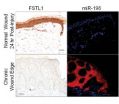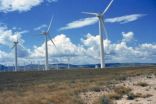(Press-News.org) MINNEAPOLIS / ST. PAUL (03/07/2013) —African lions and villagers would benefit from fences to protect them from each other, according to a new study by University of Minnesota researcher Craig Packer published online by Ecology Letters on Tuesday, March 5.
Fencing has long been anathema to most conservationists, but Packer said it offers the best hope for saving iconic African wildlife, an undertaking that will require sweeping measures rather than piecemeal efforts. In an interview, he called for an international "Marshall Plan" to erect fences where possible to protect people, lions, elephants and other threatened wildlife species.
Most African governments don't have the resources to protect people and wildlife from each other, but without a massive increase in conservation funding nearly half of unfenced lion populations could decline to near extinction over the next 20-40 years. And in the long run, it would be more cost-effective to maintain lion populations in fenced reserves.
For the study, Packer and 57 colleagues compared population densities and management practices across 42 sites in 11 countries. Fenced reserves maintained lions at 80 percent of their potential population capacity on annual management budgets of about $500 per square kilometer, while unfenced populations required an average of $2,000 per square kilometer each year to remain at just 50 percent of their capacity.
"Even though lion habitat has been reduced by at least 75 percent over the last century, more still remains than can possibly be conserved," said Packer, a professor in the Department of Ecology, Evolution and Behavior. "Several of Africa's most famous wildlife areas involve large-scale migrations of wildebeest and zebra that could never be enclosed within a fenced reserve, so the lions' last stand should be thought out carefully in terms of those places that can safely be fenced and those that will be worth the enormous monetary investments because they can't be fenced."
As encroaching civilization has brought people and lions into much closer proximity the incidence of lion attacks on humans and livestock has increased substantially. Not surprisingly, villagers retaliate by killing lions to protect their families and their livestock.
"We must never lose sight of the fact that the costs of lion conservation ultimately derive from the need to protect people from these animals," said Packer. And lions are not alone in causing widespread human misery. "Elephants are in crisis, too, and although they are largely being decimated by ivory poachers, there's little support for elephant conservation in rural villages because of the enormous damage they cause to crops. A fence that is lion-proof is also elephant-proof, so a well-designed policy of fencing would protect more than just lions."
Because the findings from the Ecology Letters paper present such an enormous challenge for African governments and conservationists, the best hope may be to advocate for a "Marshall Plan" for African wildlife conservation, Packer said.
"If we're serious about this, it means establishing fences around very large areas, such as the Selous Game Reserve, which is home to the largest remaining lion population in the world. Fencing the Selous, which covers an area of about 17,000 square miles, would cost something like $30 million. None of the world's conservation agencies could afford that, but perhaps a global funding agency for developing countries would do it because fencing would protect humans as well as lions."
Packer's own research has focused on lions in Serengeti National Park for the past 35 years. The world's most distinguished lion researcher, his studies are reported widely by national and international media.
###
College of Biological Sciences faculty conduct research in all areas of biology, from molecules to ecosystems, and apply findings create new strategies for feeding the world's growing population while restoring its ecosystems, developing renewable energy, and improving human health.
World's leading lion researcher calls for a 'Marshall Plan' for African wildlife
2013-03-08
ELSE PRESS RELEASES FROM THIS DATE:
Emotion-health connection not limited to industrialized nations
2013-03-08
Irvine, Calif., March 7, 2013 – Positive emotions are known to play a role in physical well-being, and stress is strongly linked to poor health, but is this strictly a "First World" phenomenon? In developing nations, is the fulfillment of basic needs more critical to health than how one feels? A UC Irvine researcher has found that emotions do affect health around the world and may, in fact, be more important to wellness in low-income countries.
The study, which appears online in Psychological Science, is the first to examine the emotion-health connection in a representative ...
Full wired: Planar cell polarity genes guide gut neurons
2013-03-08
The enteric nervous system (ENS), the "little brain" that resides within the gut wall, governs motility, secretion, and blood flow in the human gastrointestinal tract. Failure of the ENS to develop normally leads to congenital megacolon (Hirschsprung Disease) while loss of normal gut innervation is thought to contribute to debilitating motility disorders, such as irritable bowel syndrome. In order to prevent and treat these conditions, it is necessary to understand the molecular mechanisms that control the formation and function of the ENS. In this issue of the Journal ...
Enhanced brain acetate metabolism may reward heavy drinkers
2013-03-08
In addition to its well-known effects on the CNS, alcohol consumption has a significant impact on metabolism. After consumption, the body rapidly begins converting ethanol to acetate, which can serve as an energy source for the brain and other organs. Lihong Jiang and colleagues at Yale University used a brain imaging technique, magnetic resonance spectroscopy, to track acetate uptake and metabolism in the brains of heavy drinkers (consumed at least 8 drinks/week) and light drinkers (consumed less than 2 drinks/week). In this issue of the Journal of Clinical Investigation, ...
JCI early table of contents for March 8, 2013
2013-03-08
Enhanced brain acetate metabolism may reward heavy drinkers
In addition to its well-known effects on the CNS, alcohol consumption has a significant impact on metabolism. After consumption, the body rapidly begins converting ethanol to acetate, which can serve as an energy source for the brain and other organs. Lihong Jiang and colleagues at Yale University used a brain imaging technique, magnetic resonance spectroscopy, to track acetate uptake and metabolism in the brains of heavy drinkers (consumed at least 8 drinks/week) and light drinkers (consumed less than 2 drinks/week). ...
Genetic study of house dust mites demonstrates reversible evolution
2013-03-08
ANN ARBOR—In evolutionary biology, there is a deeply rooted supposition that you can't go home again: Once an organism has evolved specialized traits, it can't return to the lifestyle of its ancestors.
There's even a name for this pervasive idea. Dollo's law states that evolution is unidirectional and irreversible. But this "law" is not universally accepted and is the topic of heated debate among biologists.
Now a research team led by two University of Michigan biologists has used a large-scale genetic study of the lowly house dust mite to uncover an example of reversible ...
New fish species described from the streams of Manyas Lake basin, Turkey
2013-03-08
The newly described species Alburnoides manyasensis, belongs the large carp family Cyprinidae that includes freshwater fishes such as he carps, the minnows, and their relatives. This is the largest fish family, and more notably the largest family of vertebrate animals, with the remarkable numbers of over 2,400 species. Cyprinids are highly important food fish because they make the largest part of biomass in most water types except for fast-flowing rivers.
The genus Alburnoides is widely distributed in Turkey in rivers and streams of basins of the Marmara, Black and ...
Mom's sensitivity helps language development in children with hearing loss
2013-03-08
CORAL GABLES, FL (March 8, 2013) -- University of Miami (UM) Psychologist Alexandra L. Quittner leads one of the largest, most nationally representative studies of the effects of parenting on very young, deaf children who have received cochlear implants. The findings indicate that mothers who are most sensitive in their interactions with their children receiving cochlear implants have kids that develop language faster, almost "catching up" to their hearing peers. The report is published in the Journal of Pediatrics.
"I was surprised that maternal sensitivity had such ...
BRAF inhibitor treatment causes melanoma cells to shift how they produce energy
2013-03-08
A multi-institutional study has revealed that BRAF-positive metastatic malignant melanomas develop resistance to treatment with drugs targeting the BRAF/MEK growth pathway through a major change in metabolism. The findings, which will be published in Cancer Cell and have been released online, suggest a strategy to improve the effectiveness of currently available targeted therapies.
"We were surprised to find that melanoma cells treated with the BRAF inhibitor vemurafenib dramatically change the way they produce energy to stay alive," says David E. Fisher, MD, PhD, chief ...
A*STAR scientists discover 'switch' critical to wound healing
2013-03-08
Patients with diseases such as diabetes suffer from painful wounds that take a long time to heal making them more susceptible to infections that could even lead to amputations. A*STAR's discovery paves the way for therapeutics to improve healing of such chronic wounds, which are a significant burden to patients.
1. Scientists from A*STAR's Institute of Medical Biology (IMB) have identified a molecular "switch" that controls the migration of skin cells necessary for wounds to close and heal. This is especially significant for diabetics and other patients who suffer from ...
Stanford scientists calculate the carbon footprint of grid-scale battery technologies
2013-03-08
Americans take electrical power for granted whenever they flip on a light switch. But the growing use of solar and wind power in the United States makes the on-demand delivery of electricity more challenging.
A key problem is that the U.S. electrical grid has virtually no storage capacity, so grid operators can't stockpile surplus clean energy and deliver it at night, or when the wind isn't blowing.
To provide more flexibility in managing the grid, researchers have begun developing new batteries and other large-scale storage devices. But the fossil fuel required to ...


